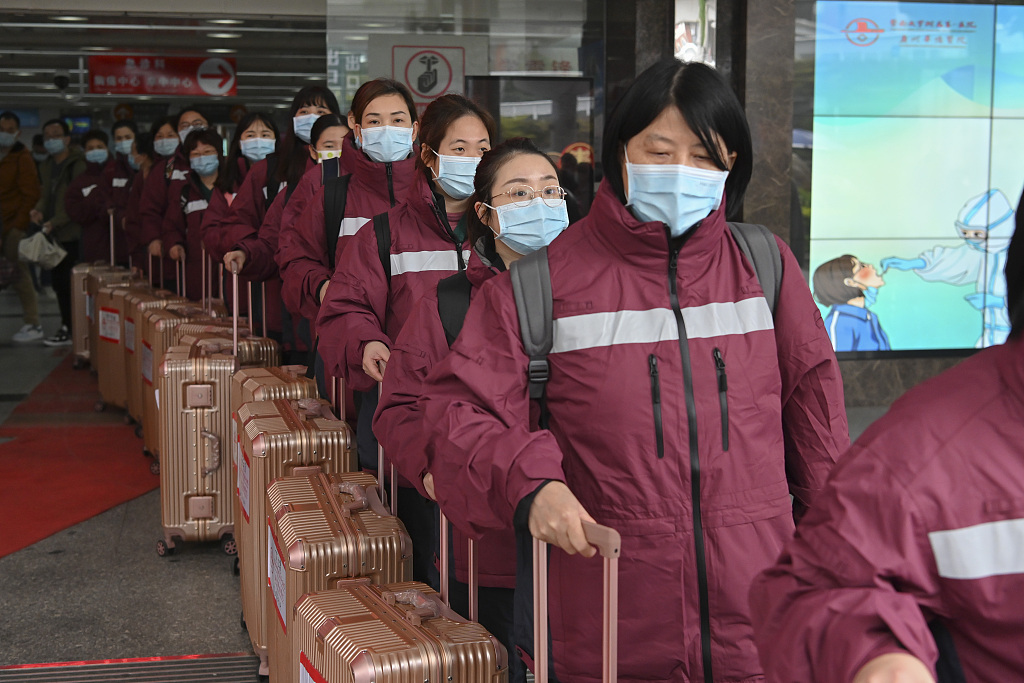
Second team of medical workers from the mainland departures from Guangzhou in south China's Guangdong Province, February 19, 2022. /CFP
Second team of medical workers from the mainland departures from Guangzhou in south China's Guangdong Province, February 19, 2022. /CFP
With support from the central authorities and people from the mainland, China's Hong Kong Special Administrative Region (HKSAR) plans to set up more isolation and treatment facilities to relieve strain off its healthcare system as the city reported 7,533 new COVID-19 cases on Monday.
The second team of 114 health experts and workers from the mainland arrived in Hong Kong Saturday to work with the SAR government in fighting the latest COVID-19 outbreak.
Also on Saturday, the construction of two community isolation and treatment facilities built with assistance from the mainland began at Penny's Bay and Kai Tak Pier in Hong Kong, respectively. The facilities are expected to provide about 9,500 quarantine units when fully operational.

First batch of vegetables from the mainland arrives at the New Yau Ma Tei Public Cargo Working Area in Hong Kong, China, February 19, 2022. /CFP
First batch of vegetables from the mainland arrives at the New Yau Ma Tei Public Cargo Working Area in Hong Kong, China, February 19, 2022. /CFP
The first batch of three tonnes of fresh Choy Sum, or Chinese flowering cabbage, arrived in Hong Kong and were dispatched to markets early Saturday via water transportation from Lianhuashan Port in south China's Guangdong Province.
Water transportation has the advantage of sending more goods while minimizing people contact, said Zhang Haibo, head of the vegetable supply company Jiexi Hongjin High-Quality Vegetables Co., Ltd.
While land transportation by trucks that used to have daily supplies of up to 10 tonnes of vegetables was largely cut due to the outbreak, Zhang said the water transportation channel allows vegetables carried to maintain quality and quantity.
"We are working overtime to raise our daily supplies to 50 tonnes to meet the demand for Hong Kong," he said.
In view of the rapid development of the fifth wave of the epidemic, the HKSAR government has taken immediate actions and, with its own continuous efforts, striven to contain the virus by a multi-pronged approach, including boosting the capacities of community testing and sewage surveillance, and strengthening contact tracing.
At the same time, the HKSAR government has adjusted its quarantine and isolation strategies, including the launch of the "StayHomeSafe" scheme on February 8 to arrange close contacts to undergo home quarantine.
Aiming for "early identification, early isolation and early treatment," the government asked persons undergoing "StayHomeSafe" to conduct regular Rapid Antigen Test (RAT). Their close contacts should take tests at the community testing center on day 12. Other home quarantine guidelines such as keeping hygiene and ventilation are also advised by the Department of Health.
The government has announced the procurement of 100 million RAT kits and has prioritized distributions for staff working in elderly and disabled care homes, according to SAR's Chief Executive Carrie Lam.
The government will also give test kits free of charge to high-risk groups, including medical workers, cross-border drivers and residents in districts where sewage testing results are positive.
Other members of the public can purchase RAT kits for voluntary testing. There are different brands of tests available in the market, most of which require nasal swab samples or deep throat saliva samples.
The government website said the test is easy to perform, and that there are sufficient supply.

